Understanding the Life Cycle of a Peacock Butterfly
The life cycle of a peacock butterfly (Inachis io) begins with the female laying clusters of tiny eggs on stinging nettle leaves, which hatch into larvae within 7 to 14 days. The voracious larvae grow rapidly, protected by spines, and molt several times.
They then enter the pupal stage, transforming inside a chrysalis over approximately two weeks, during which they are immobile and vulnerable. Upon emergence, adult butterflies undergo wing expansion and hardening before engaging in reproductive activities.
Each stage is intricately timed and critical for survival, offering a glimpse into the complexity of lepidopteran development. Learn more about each stage’s unique challenges and adaptations.
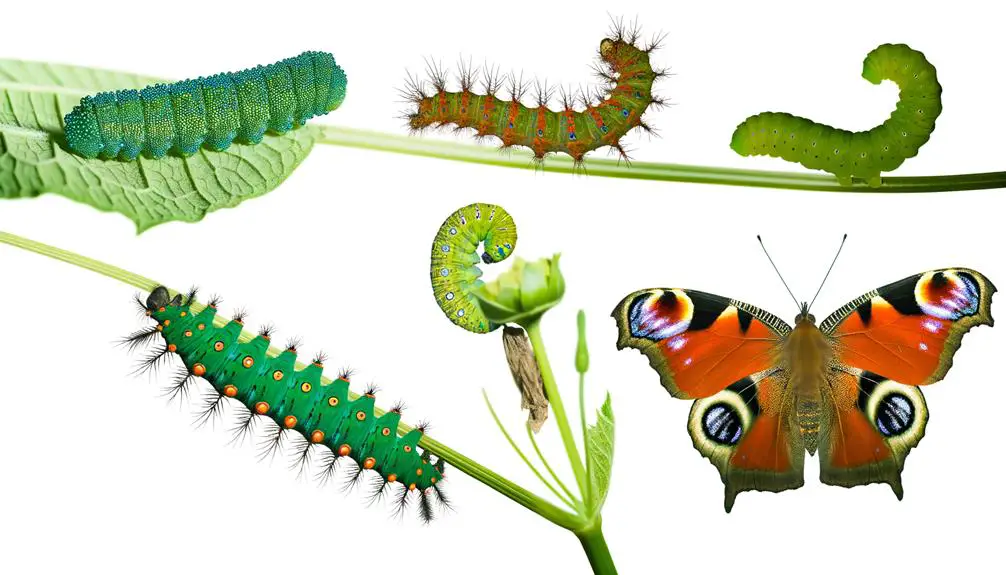
Key Takeaways
- Female peacock butterflies lay clusters of eggs on stinging nettles.
- Larvae feed voraciously on host plants, undergoing multiple molts.
- Pupation occurs within a chrysalis, where metamorphosis transforms larvae into adults.
- Adults emerge with crumpled wings that must expand and harden.
Egg Stage
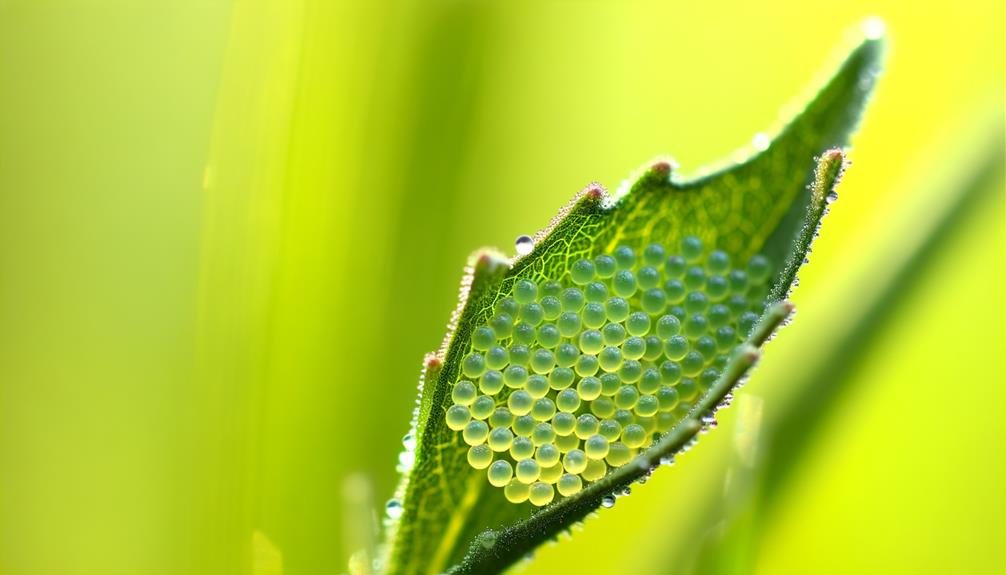
The egg stage of the Peacock butterfly (Aglais io) begins with the female depositing clusters of tiny, spherical eggs on the underside of host plant leaves, primarily stinging nettles (Urtica dioica).
Each egg measures approximately 1 mm in diameter and exhibits a pale green coloration initially, evolving to a darker hue as development progresses.
The eggs are laid in tight clusters, often numbering in the hundreds, which enhances survival rates by overwhelming predation threats.
Embryogenesis occurs within these eggs over 7 to 14 days, depending on ambient temperature conditions.
Throughout this period, the eggs undergo intricate cellular division, leading to the formation of a fully developed larva ready to emerge.
This stage is critical for ensuring the initial survival and continuity of the species.
Larval Stage
Upon hatching, larvae of the Peacock butterfly immediately begin consuming the host plant leaves, a critical activity for their growth and survival. This stage, known as the caterpillar phase, is characterized by rapid feeding and significant morphological changes. The larvae exhibit a black, spiny appearance that serves as a defense mechanism against predators.
Key characteristics of the larval stage include:
- Voracious Feeding: Continuous consumption of host plant leaves to accumulate energy reserves.
- Molting: Undergoing multiple molts to accommodate rapid growth, shedding the exoskeleton.
- Defensive Spines: Presence of spines and bristles to deter predation.
These features are essential for the larvae to progress to the next stage of development.
Pupal Stage
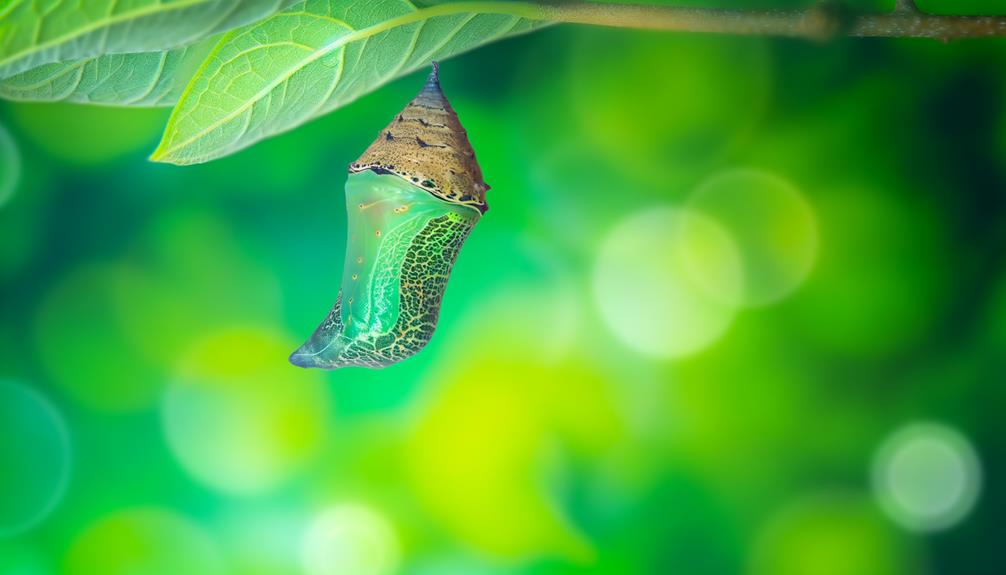
Shifting from the larval stage, peacock butterfly larvae enter the pupal stage, during which they undergo metamorphosis within a protective chrysalis. This stage is critical as the larva’s body breaks down through enzymatic processes, reorganizing into the adult form.
The chrysalis, often attached to vegetation, provides a secure environment for this transformation. Internally, larval structures dissolve, and imaginal discs, which are clusters of undifferentiated cells, develop into adult anatomical features such as wings, antennae, and reproductive organs.
This complex reorganization is regulated by hormonal changes, particularly the release of ecdysteroids. The duration of the pupal stage varies depending on environmental conditions, typically lasting about two weeks, during which the organism is immobile and vulnerable to predation.
Adult Emergence
Emerging from the chrysalis, the adult peacock butterfly undergoes a significant period of wing expansion and hardening, driven by hemolymph circulation and environmental acclimatization. This stage is essential for guaranteeing the structural integrity and functional capacity of the butterfly’s wings.
Hemolymph is pumped into the wing veins, facilitating their expansion. Subsequently, exposure to air causes the wings to dry and harden, solidifying their final form.
- The butterfly’s wings initially appear crumpled and fragile.
- Hemolymph fills the wings, causing them to expand to their full size.
- The wings must dry and harden, a process critical for flight capability.
This delicate process guarantees the butterfly’s readiness for its subsequent life stages.
Reproduction and Survival
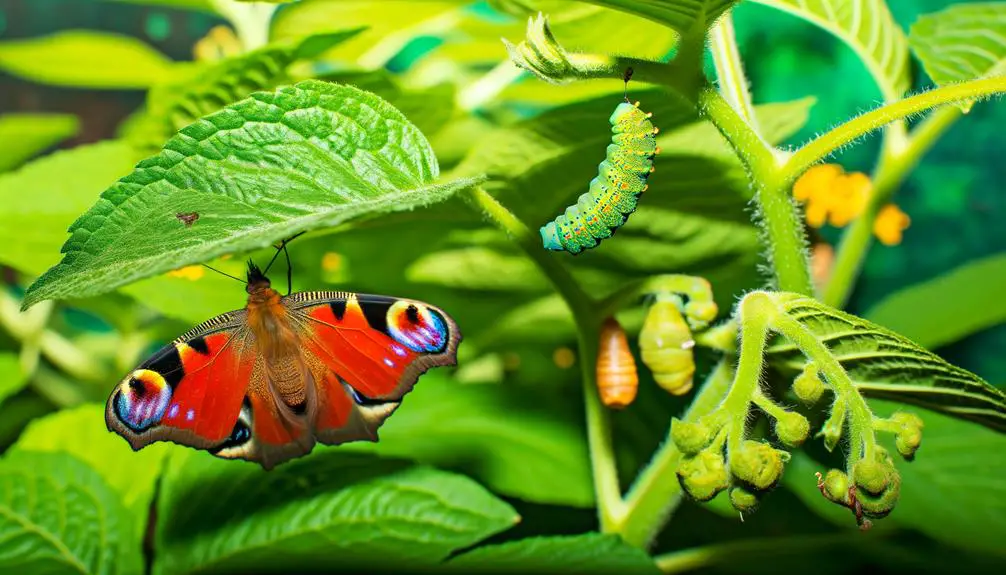
With their wings fully hardened and functional, adult peacock butterflies are now prepared to engage in reproductive activities essential for the continuation of their species.
Mating typically occurs in sunny, sheltered locations where males perform intricate courtship displays to attract females.
Post-mating, females lay clusters of eggs on host plants, mainly stinging nettles (Urtica dioica). Each female can lay several hundred eggs, ensuring genetic propagation despite predation risks.
The location of egg deposition is vital; it influences larval survival rates due to the availability of suitable foliage for feeding.
Adults primarily rely on nectar from flowers for sustenance, which also aids in energy conservation for reproductive tasks.
Survival strategies include cryptic coloration and rapid escape flights to evade predators.
Conclusion
The life cycle of the peacock butterfly, from the delicate ovum to the mature imago, epitomizes nature’s intricate choreography. The tiny eggs hatch into spiny black caterpillars that voraciously consume nettle leaves, fueling their rapid growth. After several molts, they encase themselves in chrysalides, undergoing a remarkable metamorphosis before emerging as striking adult butterflies. Similar to this transformation, the blue morpho butterfly life cycle also follows a captivating journey from egg to radiant winged beauty.
Through metamorphosis, each stage—egg, larval, pupal, and adult—embodies a unique form of existence, culminating in reproduction and the perpetuation of the species.
The cyclical journey underscores the resilience and adaptability inherent within Lepidoptera.
Consequently, the peacock butterfly’s existence is a proof of evolutionary ingenuity and the perpetuity of life through transformation and renewal.



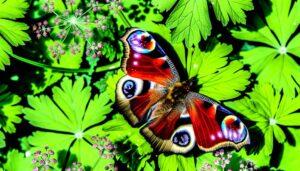



You’ll begin to drop pound after pound of fat quicker than ever earlier than, noticing it slide right off of the
scale but in addition noticing it evaporate from your physique, too.
Get prepared for a few of your favorite clothes not to fit quite as well that they use to if you run this stack for a few weeks.
In Distinction To supplements which would possibly be loaded with caffeine and different “shock boosters”, although,
this elevated vitality level isn’t going to spike and
fall like a roller coaster. As An Alternative you’ll enjoy
natural, straightforward, easy power throughout the day with no
hassle whatsoever falling asleep every evening.
Look out for merchandise with, Citrus Bergamot, Kaneka® Ubiquinol, Grape Seed Extract,
Celery Seed Extract, Astragalus, N Acetyl Cysteine,
IP6, Tudca, and Pine Bark Extract. Striking a balance
between optimizing features and minimizing potential hurt, the exploration of safer steroid practices
requires continual consciousness and knowledgeable decision-making.
Primo just isn’t actually identified to cause extreme unwanted aspect effects and
this is why it is used in greater quantities by bodybuilders and even girls.
Many British bodybuilders (and older bodybuilders) will use Primobolan stacked
alongside Testosterone to assemble a imply cycle.
However, we suggest buying from a trustworthy brand to ensure you are getting real legal steroid options (instead
of a spiked product). Complement contents are paramount in figuring
out their effectiveness and safety. Each CrazyBulk and Vintage Muscle offer products with components intended to spice up
muscle growth and testosterone.
This mixture ensures pure testosterone help, elevated vitality manufacturing, and better total performance.
D-Bal increases nitrogen retention, a important component of protein synthesis.
With extra nitrogen in your system, your physique enters a highly anabolic state—perfect for constructing muscle mass faster whereas minimizing
muscle breakdown.
CrazyBulk merchandise are readily available by way
of their official website, which presents a variety
of bulking, chopping, and energy stacks. Moreover, choose CrazyBulk merchandise could be discovered on various
different online retail platforms. In distinction, Vintage Muscle
has confronted criticism for probably underdosed components or blends that may not disclose all lively substances.
The lack of transparency could result in sudden outcomes or
unwanted effects.
HyperGH 14X is a potent HGH releaser which works great for bodybuilding.
Testofuel makes use of a mixture of steroid like elements similar to D-Aspartic Acid, Fenugreek extract, and Oyster extract which
were proven in scientific research to behave
on male hormones. While Progress Issue 9 is not really a steroid (or actual HGH for that matter), it CAN help to imitate the effects of real HGH.
If you’re looking for an efficient and LEGAL alternative to steroids, you
want to check out our review of Chemyo right here. Even higher, if you purchase two months of any of
the complement stacks for mass out there, you’ll get a third month utterly free.
In common, this class of ingredients helps your body
burn fats as fuel and will increase your endurance.
Moreover, Dr. Stopanni pointed out, acetyl-L-carnitine
presents the advantage of being more easily absorbed into your
body. Began my first “cycle” (8 weeks) again in august 2023 after the tip of a reduce going right into a bulk and its could 2024 at the
time of me writing this. Followed the really helpful 8 weeks
on however took 2 weeks off just incase and somewhat bit of OCD.
Solely “criticism” I have is I began to develop zits on my chest and forehead.
HOWEVER, this can be due to me utilizing the identical fitness center hat everyday with minimal
washes and utilizing the same hoodie everyday
for fasted cardio in the morning. Possibly a little little
bit of this product and my hygiene performed a part in that.
Let us see how Muscle Labs USA Dietary Supplements offers you the best for you.
As the matter of reality Muscle Labs USA Dietary
Supplements has gained a quantity one submit in the market of
authorized steroids. Whereas now feeling extra duty
to serve and provide best authorized steroids. The trade of bodybuilding had lots to offer and launched mainly issues to
help people proper and match body. However, the dietary supplements these days are the important half
on this fitness world.
Value per ServingWe in contrast the cost-effectiveness of each steroid, considering the variety
of servings per package and the recommended
dosage to determine which product offers higher worth
for cash. My dietitian additionally pointed out
that the choline included can help with fats loss and urge for food suppression, making
it easier to increase fasting occasions [2].
All our shoppers mentioned that they had no unwanted side effects and also reported good improvements
in power gains. Ideally, plan to take the total three
capsules about 30 to 40 minutes before you hit the health club.
Another authorized steroid, Anadrole, is out there at an analogous value level of $54.ninety nine per bottle,
with 30 servings.
As a safe and authorized product, Trenorol stands out from
many performance enhancers, having no extreme unwanted side effects.
D-BAL earns its status by replicating the consequences of Methandrostenolone,
a substance broadly generally identified as Dianabol, sans the unwanted side effects.
It accomplishes this without using artificial hormones or steroids.
D-BAL operates by way of a unique mix of natural elements to reinforce
nitrogen retention in muscle tissues.
References:
JBH News
What a material of un-ambiguity and preserveness of precious know-how on the topic of unpredicted emotions.
Stop by my webpage; nordvpn coupons inspiresensation (tinyurl.com)
Exceptional post but I was wanting to know if you could write a litte more on this topic?
I’d be very grateful if you could elaborate a little bit more.
Kudos!
My web-site :: nordvpn coupons inspiresensation
I am now not certain the place you are getting your info, but
good topic. I must spend some time finding out more or working out more.
Thank you for magnificent info I was on the lookout for this info for my mission.
my web site; nordvpn coupons inspiresensation (http://cia.sh/nordvpn-coupons-inspiresensation–93990)